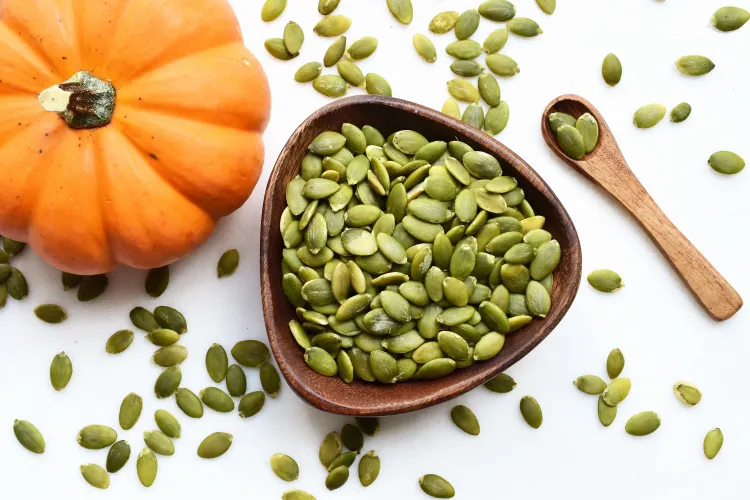Introduction
Pumpkin seeds pack a nutritional punch, offering high-quality protein, fiber, healthy fats, and essential minerals. Whether you prefer the whole, shell-on seeds or the shelled pepitas, these tiny powerhouses can be enjoyed in a variety of ways—from simple snacks to ingredient power-ups in meals. Here’s what you need to know about their nutrition, preparation, and storage.
Section 1: Whole Seeds vs. Shelled Pepitas
- Whole pumpkin seeds (with shells)
- Flavor and texture: Mildly nutty with a slight crunch from the shell.
- Nutrition highlights: Higher in fiber, potassium, and zinc per serving.
- Ideal uses: Snacking, toppings for salads, or adding crunch to granola.
- Pepitas (shelled pumpkin seeds)
- Flavor and texture: Softer, creamier bite and a richer flavor without the shell.
- Nutrition highlights: Higher in protein, total fat, iron, magnesium, and phosphorus.
- Ideal uses: Baking, smoothies, pestos, and as a crunchy mix-in for bowls.
Section 2: Nutrition Snapshot
- Whole pumpkin seeds (1 oz roasted)
- Protein: about 5.2 g
- Total fat: ~5.5 g
- Fiber: ~5.2 g (about 19% DV)
- Magnesium: ~74 mg (18% DV)
- Zinc: ~2.9 mg (about 27% DV)
- Potassium: ~261 mg (6% DV)
- Iron: ~0.94 mg (5% DV)
- Pepitas (1 oz roasted)
- Protein: about 8.5 g
- Total fat: ~13.9 g
- Fiber: ~1.8 g (7% DV)
- Magnesium: ~156 mg (37% DV)
- Phosphorus: ~332 mg (27% DV)
- Iron: ~2.3 mg (13% DV)
- Potassium: ~223 mg (5% DV)
- Zinc: ~2.2 mg (20% DV)
Note: Values can vary by variety and preparation. Both forms provide beneficial fats (mostly monounsaturated and polyunsaturated) and plant compounds like phytosterols and polyphenols that support overall health.
Section 3: Health Benefits
- Heart health: Healthy fats and magnesium support cardiovascular well-being.
- Digestive health: The fiber in whole seeds aids digestion and helps with satiety.
- Mineral intake: Zinc, magnesium, iron, and phosphorus contribute to immune function, energy production, and bone health.
- Phytochemicals: Plant compounds in pumpkin seeds may support antioxidant and anti-inflammatory processes.
Section 4: How to Prepare and Enjoy
- Raw vs. roasted
- Raw seeds offer a lighter, slightly bitter flavor and crisp texture that some prefer.
- Roasted seeds deepen the nutty flavor and add a satisfying crunch. Lightly season for extra taste.
- How to roast (for whole seeds and pepitas)
- Preheat oven to 350°F (176°C).
- Remove any pumpkin strings; rinse the seeds if needed; pat dry thoroughly.
- Toss with a small amount of olive oil and your favorite seasonings (salt, paprika, garlic powder, cumin, chili flakes, or cinnamon-sugar for a sweet option).
- Spread in a single layer on a baking sheet.
- Roast:
- Whole seeds: 20–30 minutes, stirring once or twice until golden brown.
- Pepitas: 10–15 minutes, keep an eye on them as they can burn quickly.
- Cool and store in an airtight container.
Section 5: Storage and Shelf Life
- Store-bought, dried seeds (roasted or plain): Keep in an airtight container in a cool, dry place for about 3 months. For longer freshness, refrigerate up to 6 months or freeze up to a year.
- Fresh-from-a-pumpkin seeds: Higher moisture content means shorter shelf life. Rinse, dry completely, and use or roast within a few days. Once roasted, store as above and use within 1–2 weeks for best crunch.
- Signs of spoilage: Rancid or off smells, off-taste, or visible mold indicate it’s time to discard.
Section 6: Recipe Ideas and Uses
- Granola boost: Stir roasted pumpkin seeds into homemade granola with oats, nuts, honey, and dried fruit.
- Salad crunch: Sprinkle over greens with quinoa or farro for extra protein and texture.
- Pesto twist: Swap pine nuts for pepitas in pesto for a gluten-free, nut-free alternative.
- Snack bites: Combine pepitas with oats, peanut butter, and dark chocolate to make no-bake energy bites.
- Crusted proteins: Use crushed pumpkin seeds as a crust for chicken or fish for a toasty, savory coating.
Section 7: Shopping Tips
- Choose based on use: If you want more fiber and a stronger shell-texture, go for whole seeds; if you want higher protein and minerals, pepitas are a great option.
- Look for freshness: Check packaging dates and store in a cool, dry place away from sunlight to preserve flavor and nutrients.
- Consider pre-roasted vs. raw: Roasted seeds are convenient, but raw seeds can be roasted at home to control seasoning and salt.
FAQs
- Are pumpkin seeds safe for most people?
- Yes for most people when eaten in moderate amounts. If you have a tree nut or seed allergy, consult your healthcare provider before adding them to your diet.
- Do pumpkin seeds need to be refrigerated?
- Not always, but refrigeration can extend freshness, especially for stored seeds that have already been roasted or salted.
- Can pumpkin seeds help with hunger control?
- The combination of protein, fiber, and healthy fats can promote satiety, which may help with appetite regulation when eaten as part of balanced meals or snacks.
- Are there differences in nutrition between raw and roasted seeds?
- Roasting can reduce some heat-sensitive nutrients slightly and may concentrate flavors and fats depending on the method. Overall, both forms are nutritious; flavor and texture preferences often guide preparation choice.
- How much should I eat in a day?
- A typical serving is about 1 ounce (roughly a small handful). You can adjust based on your calorie needs and dietary goals.
Conclusion
Pumpkin seeds are a versatile, nutrient-dense snack and pantry staple. Whether you enjoy them whole with their shells or as shelled pepitas, they offer valuable protein, fiber, minerals, and healthy fats. With simple roasting methods and smart storage, you can keep pumpkin seeds fresh and flavorful for months while exploring a wide range of tasty, healthful uses.
